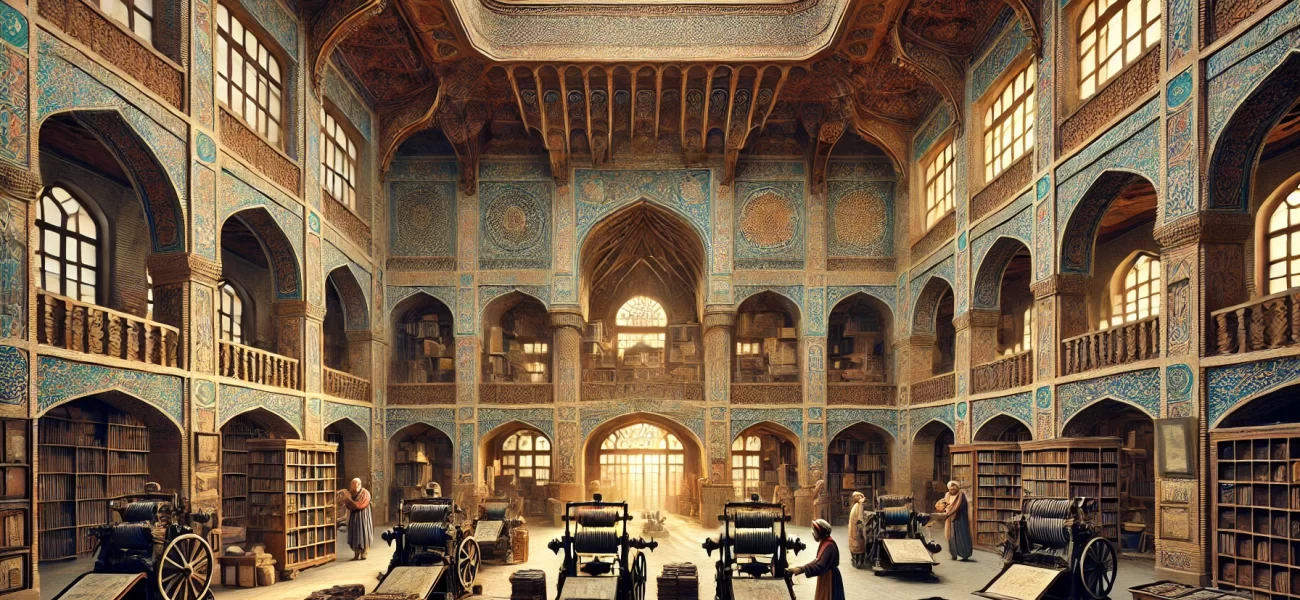The story of printing in Iran is more than just the narrative of machines, ink, and paper—it is the chronicle of a nation’s struggle to bring the written word to life amidst political upheaval, social change, and the inexorable rise of modernity. For centuries, Iran was a land of eloquent poets, philosophers, and scholars, where knowledge flowed through the rhythmic recitation of verse, the calligraphic beauty of manuscripts, and the oral transmission of wisdom. But the advent of printing would change the very fabric of how Iranians communicated, learned, and disseminated ideas.
In this journey, we will traverse through the history of printing in Iran, from its hesitant beginnings in the Safavid era to its profound influence on the nation’s sociopolitical movements in the Qajar and Pahlavi periods. With the passion of a historian and the sensitivity of a literary soul, I shall recount the birth of printing houses in Iran—those humble bastions of knowledge that quietly revolutionized the country’s intellectual and cultural landscape.
The Manuscript Tradition: Before the Presses Arrived
Before the introduction of printing in Iran, knowledge was painstakingly recorded by hand. Manuscripts, with their flowing Nasta’liq script and elaborate illuminations, were regarded as treasures of both intellectual and artistic value. Books were copied by hand, a process that often took months or even years, resulting in beautifully bound volumes that were considered rare and precious commodities. The great libraries of Iran’s past, from the magnificent centers of learning in Nishapur and Rey to the fabled manuscripts of the Safavid court, were repositories of this meticulous labor.
Iran’s scholars, poets, and theologians continued a tradition of handwritten knowledge that stretched back over a millennium, fostering a literary culture in which calligraphy was more than a functional tool; it was a form of artistic expression. Books and texts were viewed as living entities—embodiments of the soul of the scholar who had painstakingly written them. In such an environment, the notion of mechanical reproduction was initially met with resistance, even disdain. How could a machine replace the human hand, the essence of craftsmanship?
Yet, by the 17th century, the winds of change were blowing. The outside world, especially Europe, was fast adopting the printing press as the harbinger of a new intellectual era. Iran, ruled by the Safavids, was not immune to these winds. Diplomats, merchants, and travelers brought back tales of the remarkable power of the press from the West, and the seeds of this new technology began to take root.
Early Encounters with Printing: The Safavid Curiosity
The first encounter with printing technology in Iran dates back to the Safavid period, particularly under Shah Abbas I (1587–1629). Shah Abbas, the great monarch who transformed Isfahan into a dazzling imperial capital, was deeply interested in fostering connections with the outside world. As part of his efforts to expand diplomatic and commercial relations with Europe, he became aware of the printing revolution taking place in the West.
The Safavid court welcomed foreign diplomats, many of whom hailed from countries where printing presses had become indispensable tools for communication and governance. Catholic missionaries from Europe, particularly the Jesuits, arrived in Iran, bringing with them knowledge of printing techniques. However, the technology remained something of an exotic curiosity in the Safavid court, never quite taking root in the broader Iranian culture. In fact, the first actual printed works produced in Iran were not in Persian at all—they were religious texts produced by the Armenian community in New Julfa, a suburb of Isfahan established by Shah Abbas to house Armenians displaced from the Ottoman Empire.
In 1638, the first printing press in Iran was set up by the Armenian community in New Julfa, producing religious texts in the Armenian language. This press was primarily intended to serve the needs of the Armenian Christian population, and thus its impact on broader Persian literary culture was minimal. Nevertheless, it marks a significant moment in the history of printing in Iran, as it introduced the mechanics of the printing process to Iranian soil.
For nearly two centuries after this initial experiment, however, Iran would remain largely untouched by the printing revolution that was sweeping across Europe and Asia. Political instability, the decline of the Safavid dynasty, and a general ambivalence toward foreign technology all contributed to the delay in adopting the press.
The Advent of Persian Printing: The Qajar Era
It was not until the early 19th century, during the reign of the Qajar dynasty, that printing in Persian truly began to take hold. By this time, European influence had increased significantly, and the Qajar rulers were eager to modernize their state. They realized that the printing press could serve as a powerful tool for administration, education, and governance.
The first Persian-language printing press was established in Tabriz in 1816, under the auspices of Abbas Mirza, the reform-minded crown prince. A visionary leader, Abbas Mirza sought to modernize Iran’s military and educational institutions, and he saw the potential of the printing press as a means of spreading knowledge and advancing state reforms. The press in Tabriz produced Persian translations of European military manuals, scientific treatises, and official government publications. It was a modest start, but it signaled the beginning of a new era in Iranian intellectual history.
Shortly after, the Dar al-Fonun, Iran’s first modern polytechnic institution, was established in Tehran in 1851. Alongside its mission to educate Iran’s future scientists, engineers, and bureaucrats, Dar al-Fonun became a key center for publishing. The institution had its own printing house, where texts on various subjects—ranging from mathematics and engineering to medicine and philosophy—were produced for the school’s students. This marked the beginning of a more sustained and systematic effort to make printed books and educational materials accessible to a broader audience in Iran.
The Birth of Newspapers: A New Voice for the People
Perhaps the most revolutionary impact of the printing press in Iran came with the advent of newspapers. In the 19th century, newspapers became the primary medium through which Iranians could engage with the political and social issues of the day. The first Persian-language newspaper, Kaghaz-e Akhbar, was published in Tehran in 1837 during the reign of Mohammad Shah Qajar. Initially, these early newspapers were government-controlled and primarily used to disseminate official decrees and proclamations, but they soon evolved into a vibrant medium for public discourse.
By the late 19th century, newspapers had become central to the nascent Iranian intelligentsia and their efforts to advocate for reform and modernization. Intellectuals such as Mirza Malkum Khan, Mirza Aqa Khan Kermani, and Mirza Fath Ali Akhundzadeh began publishing periodicals and pamphlets that critiqued the corruption and inefficiency of the Qajar state. These publications often found their way into the hands of the educated elite and, in some cases, the general public, sparking debates about constitutionalism, nationalism, and the role of religion in public life.
The proliferation of printing houses in Tehran, Tabriz, and other major cities during this period reflected the growing demand for printed material. From government bulletins to philosophical treatises, from military manuals to satirical pamphlets, the printed word began to penetrate the fabric of Iranian society in unprecedented ways. The press became a medium of resistance—a weapon for the disenchanted and the reformists, and a tool for political movements seeking change.
Printing and the Constitutional Revolution
By the turn of the 20th century, Iran was in the throes of a major political transformation. The Constitutional Revolution of 1905-1911 was the first major movement in the modern Middle East that sought to limit the powers of the monarchy and establish a representative form of government. The role of printing and the press during this period was nothing short of revolutionary.
Newspapers such as Sur-e Esrafil and Habl al-Matin played a pivotal role in rallying public support for the constitutionalists. These publications fiercely criticized the despotic rule of Mozaffar al-Din Shah and later Mohammad Ali Shah, calling for an end to arbitrary governance and the establishment of a constitutional assembly. The proliferation of printing presses during this period, particularly in Tehran, allowed for the rapid dissemination of revolutionary ideas, both within Iran and across the wider Persian-speaking world.
Perhaps most importantly, printing houses allowed for the mass production of the Constitution itself, as well as the various manifestos and declarations that defined the revolution. For the first time, large numbers of ordinary Iranians had access to the texts that would shape their country’s future. Printing became a form of activism, as the constitutionalists used the power of the press to challenge the traditional structures of power and mobilize a new political consciousness among the Iranian public.
Pahlavi Modernization and the Expansion of Printing
With the rise of the Pahlavi dynasty in the 1920s, Iran underwent a series of sweeping modernizations, many of which were aimed at industrializing the country and consolidating the state’s power. Reza Shah Pahlavi, the founder of the dynasty, was deeply committed to creating a centralized and modernized state, and the expansion of the printing industry was a key component of this vision.
Under the Pahlavis, the government invested heavily in the creation of state-run printing houses that could produce textbooks, government publications, and propaganda materials. The establishment of the Ministry of Culture and Arts in the mid-20th century further centralized control over the production of printed materials. At the same time, privately owned printing houses flourished, and by the 1940s, Iran had developed a vibrant publishing industry, with numerous printing houses operating in Tehran, Isfahan, Shiraz, and other major cities.
The expansion of printing during the Pahlavi era was closely tied to the regime’s efforts to promote literacy and education. The publication of textbooks, newspapers, and literary works in Persian became a central part of the state’s modernization agenda. Printing houses churned out textbooks for the expanding school system, while the government’s push for literacy campaigns helped create a new generation of readers who were eager to consume the printed word.
The Islamic Revolution and the Post-Revolutionary Press
The events of the Islamic Revolution of 1979 once again underscored the power of the press in shaping public opinion and mobilizing political movements. During the revolution, opposition groups, particularly those aligned with Ayatollah Khomeini, utilized printing presses to disseminate revolutionary literature, pamphlets, and sermons. These printed materials were instrumental in spreading the message of the revolution and galvanizing public support for the overthrow of the Pahlavi regime.
In the post-revolutionary period, the Islamic Republic established a new framework for regulating the press. While the government took control of many of the country’s printing houses, the Iranian press remained a vital arena for political discourse, with numerous newspapers, magazines, and journals continuing to shape the intellectual and cultural life of the nation.
The history of printing in Iran is a testament to the power of the written word to shape societies, cultures, and political movements. From its early beginnings in the Safavid period to the revolutionary presses of the 20th century, printing has played an indispensable role in the evolution of Iranian society. It has allowed knowledge to be disseminated more widely than ever before, transforming the intellectual landscape of the country and laying the foundation for modern Iran’s vibrant literary and political culture.
The printing houses of Iran are not merely industrial spaces filled with machinery—they are the repositories of a nation’s soul, where the ideas, dreams, and struggles of generations have been inked onto the page. The clattering of the printing press has long since become a symbol of progress, resistance, and enlightenment in Iran, and its legacy continues to reverberate in the nation’s ongoing journey towards intellectual freedom and expression.




